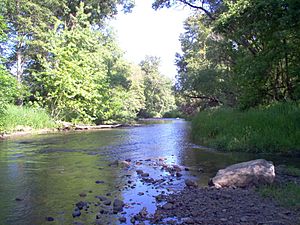Bear Creek (Rogue River tributary) facts for kids
Quick facts for kids Bear Creek |
|
|---|---|

|
|
|
Location of the mouth of Bear Creek in Oregon
|
|
| Country | United States |
| State | Oregon |
| County | Jackson |
| Physical characteristics | |
| Main source | Near Emigrant Lake 1,842 ft (561 m) 42°11′40″N 122°39′52″W / 42.19444°N 122.66444°W |
| River mouth | Rogue River Central Point 1,168 ft (356 m) 42°25′56″N 122°58′13″W / 42.43222°N 122.97028°W |
| Length | 28.80 mi (46.35 km) |
| Basin features | |
| Basin size | 361 sq mi (930 km2) |
Bear Creek is a stream located entirely within Jackson County, Oregon. It flows through the beautiful Rogue Valley, covering about 400 square miles (1,036 km²). Each year, it sends about 114 cubic feet of water per second into the Rogue River.
Starting near Emigrant Lake, Bear Creek travels about 28.8 miles (46.3 km). It passes through several towns. These include Ashland, Talent, Phoenix, Medford, and Central Point.
Bear Creek's Past
Long ago, before settlers arrived in the 1850s, the Bear Creek Valley was home to Native American tribes. These included the Takelmas, the Latgawas, and the Shastas. They lived in scattered camps. They hunted deer and elk, fished for salmon, and gathered foods like plums, sunflowers, and root vegetables.
The native people called the stream Si-ku-ptat. Early settlers might have known it as Stewart River.
During the 1850s, many Native American people were moved to reservations. By 1857, almost all of them had left the area. Farmers and ranchers continued to claim land. When the Oregon and California Railroad arrived in 1883, it followed the path of Bear Creek.
How Bear Creek Was Formed
The Bear Creek watershed is a curved valley. It is actually part of the larger Rogue Valley. This valley is about 13 miles (21 km) wide and 28 miles (45 km) long. It covers about 361 square miles (935 km²). Bear Creek joins the Rogue River at the northwestern end of the valley.
The highest point in the watershed is on Mount Ashland. It is about 7,500 feet (2,286 meters) high. From there, at least 83 smaller streams flow into Bear Creek. These streams are part of 21 smaller watersheds that connect to the bigger Rogue River Basin.
The land around the watershed has been shaped by tectonic activity. This has created steep canyons. These canyons can flood when snow melts in the spring. The slopes are a mix of volcanic soil and granitic soil. This type of soil is common in Southern Oregon and Northern California.
The area can have a lot of erosion and runoff when the water flows quickly. The elevation of the watershed where Bear Creek meets the Rogue River is about 1,075 feet (328 meters). A lot of energy builds up as the water drops over 5,000 feet (1,524 meters) from its source. The natural landscape usually helps control this energy. However, flooding has become a regular problem along Bear Creek. In the past, several bridges in the Rogue Valley were washed away during big floods.


